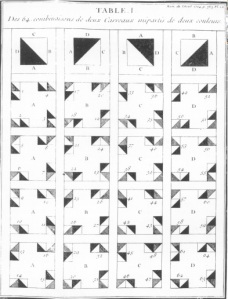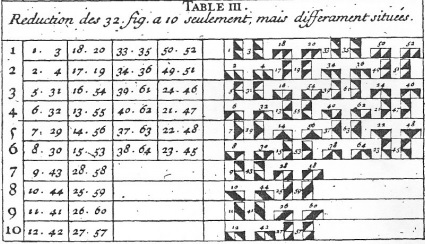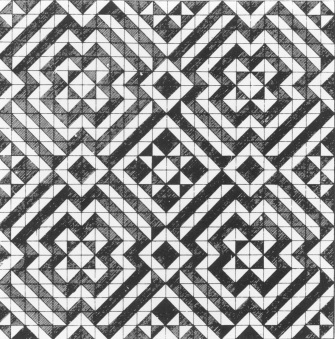Welcome to this week’s Math Munch!
Why all the excitement about Truchet? And what (or who?) is Truchet, anyway? Great questions, both. I only recently learned about the fascinating world of Truchet and his tiles. I first got hooked on the beautiful patterns you can make with Truchet tiles. So, read on– and maybe you’ll get hooked, too.
This beautiful pattern is made out of Truchet tiles, deceptively simple square pieces that can fit together to make patterns with enormous complexity. There’s really just one Truchet tile– the square with a triangular half of it colored it– but it can be oriented in four ways.
![]() There are ten different ways to put two next to each other– or, at least, that’s what Sebastien Truchet discovered when he started working with these tiles way back in the late 1600s. Truchet was a scientist and inventor, but he also dabbled in math. He became interested in the ways of combining these simple tiles while looking at decorations made from ceramic tiles. He started trying to figure out all the different patterns he could make– first with two tiles, then with sequences of them– and soon realized that he was the first person to study this! So, he wrote a little book about his discoveries, which he called “Memoir sur les Combinasions.”
There are ten different ways to put two next to each other– or, at least, that’s what Sebastien Truchet discovered when he started working with these tiles way back in the late 1600s. Truchet was a scientist and inventor, but he also dabbled in math. He became interested in the ways of combining these simple tiles while looking at decorations made from ceramic tiles. He started trying to figure out all the different patterns he could make– first with two tiles, then with sequences of them– and soon realized that he was the first person to study this! So, he wrote a little book about his discoveries, which he called “Memoir sur les Combinasions.”
 Translations of this book are hard to come by (unless you read French), but I found a great site that shows all the images Truchet included in the book. One of my favorites is this chart, in which Truchet shows all the possible ways of combining two tiles. Maybe you’ve noticed that there are way more than ten different combinations on this chart. That’s because this chart is just Truchet brainstorming– drawing everything he can think of. In a later chart, Truchet groups pairs of tiles that he thinks are the same in some really basic way.
Translations of this book are hard to come by (unless you read French), but I found a great site that shows all the images Truchet included in the book. One of my favorites is this chart, in which Truchet shows all the possible ways of combining two tiles. Maybe you’ve noticed that there are way more than ten different combinations on this chart. That’s because this chart is just Truchet brainstorming– drawing everything he can think of. In a later chart, Truchet groups pairs of tiles that he thinks are the same in some really basic way.
Can you see how Truchet grouped the tiles in this chart? Each row corresponds to one of his ten different tiles. Do his categories make sense?

 Want to try making a beautiful Truchet tiling of your own? You could just start drawing (maybe graph paper would be useful). Or you could try this great Scratch program! You can have it make a random Truchet tiling. Or, you can use a four-digit code, using only the digits 1 through 4, to tell it what pattern to make. Each digit corresponds to a tile with a dark triangle in a different corner. I had fun thinking of a code and then trying to guess what pattern the program would make. Or, you could try to figure out the code for one of your favorite of Truchet’s patterns!
Want to try making a beautiful Truchet tiling of your own? You could just start drawing (maybe graph paper would be useful). Or you could try this great Scratch program! You can have it make a random Truchet tiling. Or, you can use a four-digit code, using only the digits 1 through 4, to tell it what pattern to make. Each digit corresponds to a tile with a dark triangle in a different corner. I had fun thinking of a code and then trying to guess what pattern the program would make. Or, you could try to figure out the code for one of your favorite of Truchet’s patterns!
In recent years, mathematicians have starting experimenting with Truchet tiles in new ways. The mathematician and scientist Cyril Stanley Smith was one of the first to do this. He began to introduce curved lines into the tiles and to place them randomly, instead of according to a pattern. These changes make some really interesting results– like this maze made from Truchet-like tiles.
Want to make your own maze from tiles inspired by Truchet? Check out this site with instructions for how to make Truchet mazes! You can use a computer or a more low-tech tool to create an intricate, unique maze.
Bon appetit!


Great patterns!
I’ve just madea Word doc to play about with too – https://www.dropbox.com/s/u3453786kjm4b9w/Truchet.docx
– with the grid settings at 4cm and snapping to grid; just select a tile and rotate it.
Hi, Simon! This is really great– thanks for sharing. I’d like to use it in my math art class– is that ok with you?
of course, Anna.
(I use the grid settings on Word for quite a lot of things – making tesselations for instance)
Great! Thanks! I never thought of using grids on Word to make tessellations… that’s a great idea.
I’ve used Word a lot for tessellations with kids. The snapping to grid means the shape fits, when you copy and paste it (then you can group a whole load of tiles and copy and paste them for quick results.)
I often start with a rectangle, then with snap to grid on and display gridlines on I get them to create a freeform shape on top of that rectangle with a chunk out of one side that’s added on the other side Escher-style.
https://www.dropbox.com/sh/x5hbjn2j7cibhjt/wy0Bdk8CwW
That snap-to-grid feature makes Word a useful maths tool. Spotted this today: http://youtu.be/PDQfLRu0d3Y
That is very cool. I had no idea Word was so useful as a manipulative…
Do you know the board game Tsuro? In it, you end up building a path/maze thing that reminds me of the maze you included. You can see some pictures if you scroll down on this page: http://boardgamegeek.com/boardgame/16992/tsuro
That’s a good link Evelyn – I guess Tantrix is a cousin too:
Makes me wonder what the simplest Truchet tiles are that would also make a game…
Hey Evelyn! I’m not familiar with this game, though it sounds like Entanglement, which you can play online:
http://entanglement.gopherwoodstudios.com/
Very addicting.
These tiles remind me of the mosaics in the MoMath restrooms.
Hi Japheth! Now that I think of it, they do… I wonder if the tilings are actually inspired by Truchet or another riff on the same idea.
Quilters love this block too! We call them “half square triangles” or HSTs.
I’ve done several activities with students designing quilts – art, patterning, tessellation, and more.
A few years ago I made up a set of worksheets to have my students learn some of the traditional blocks, make up their own combinations, then pick their favorite block to colour a full page quilt.
This activity was a hit with grade 1 through 8 – by choosing a limited pallet, every quilt looke great!
I repeated this activity with a life skills class that I worked with last year – over several months we practiced planning, patterning, fine motor skills, and more.
Hi, Sarah! Thanks for the comment. Since I made this post I’ve noticed more and more quilts that use Truchet tilings. My mom likes to embroider, and she’s considering making an embroidery pattern that involves Truchet.
I’m very interested in your lesson plans– would you be willing to share them?
These are wonderful. Thanks for turning me on to Truchet!
Hi, Elaine! You’re welcome!
Thanks, Simon! That’s cool.
The mazes remind me of entanglement, http://entanglement.gopherwoodstudios.com/. Also an app in Chrome/iOS/droid
I didn’t see this comment until after I posted my own about Entanglement. 🙂 Good find. Thanks for sharing!
Finally got a chance to make my own. It was very fun, and there’s a GeoGebraTube sketch for anyone to use. http://mathhombre.blogspot.com/2014/05/truchet.html
Here’s a random pattern generator using a Truchet tile containing two arcs, written with Javascript:
http://www.gallixa.com/truchet.html
Pingback: Dot Grid Doodling | Denise Gaskins' Let's Play Math